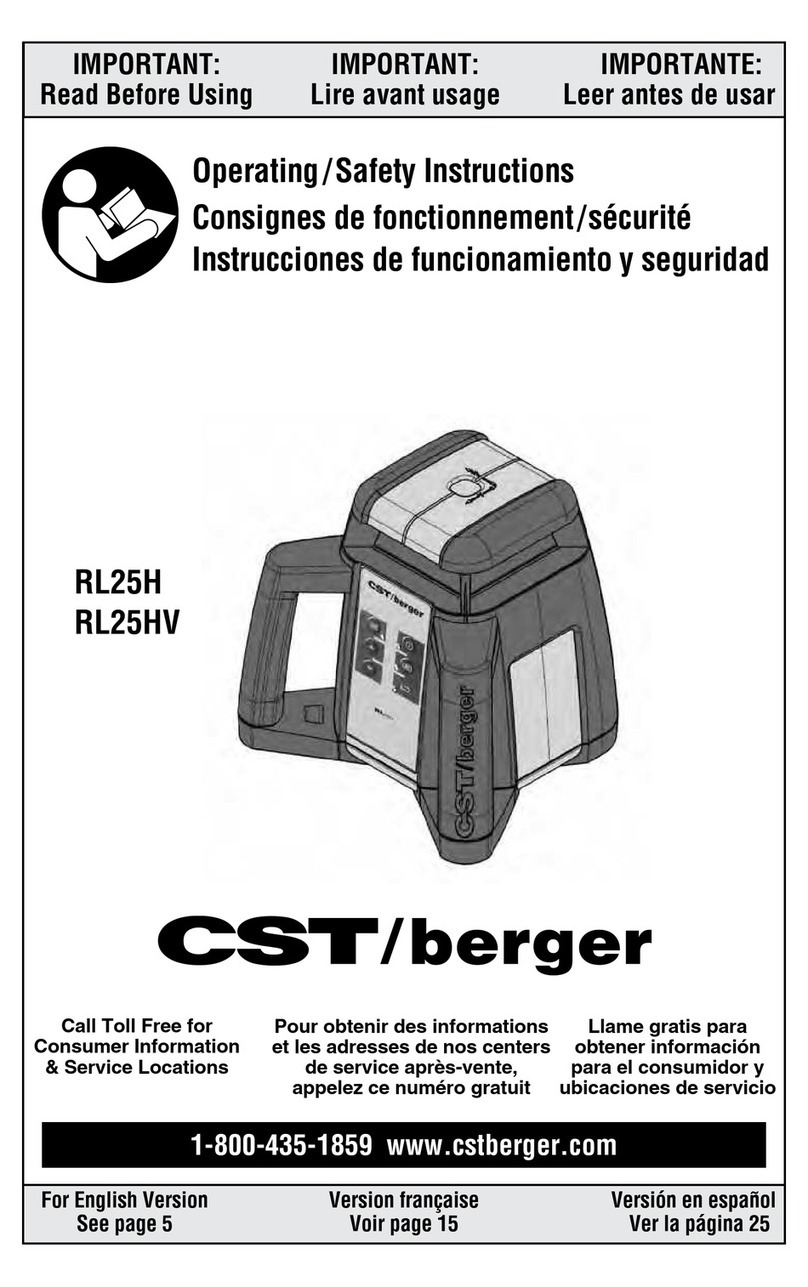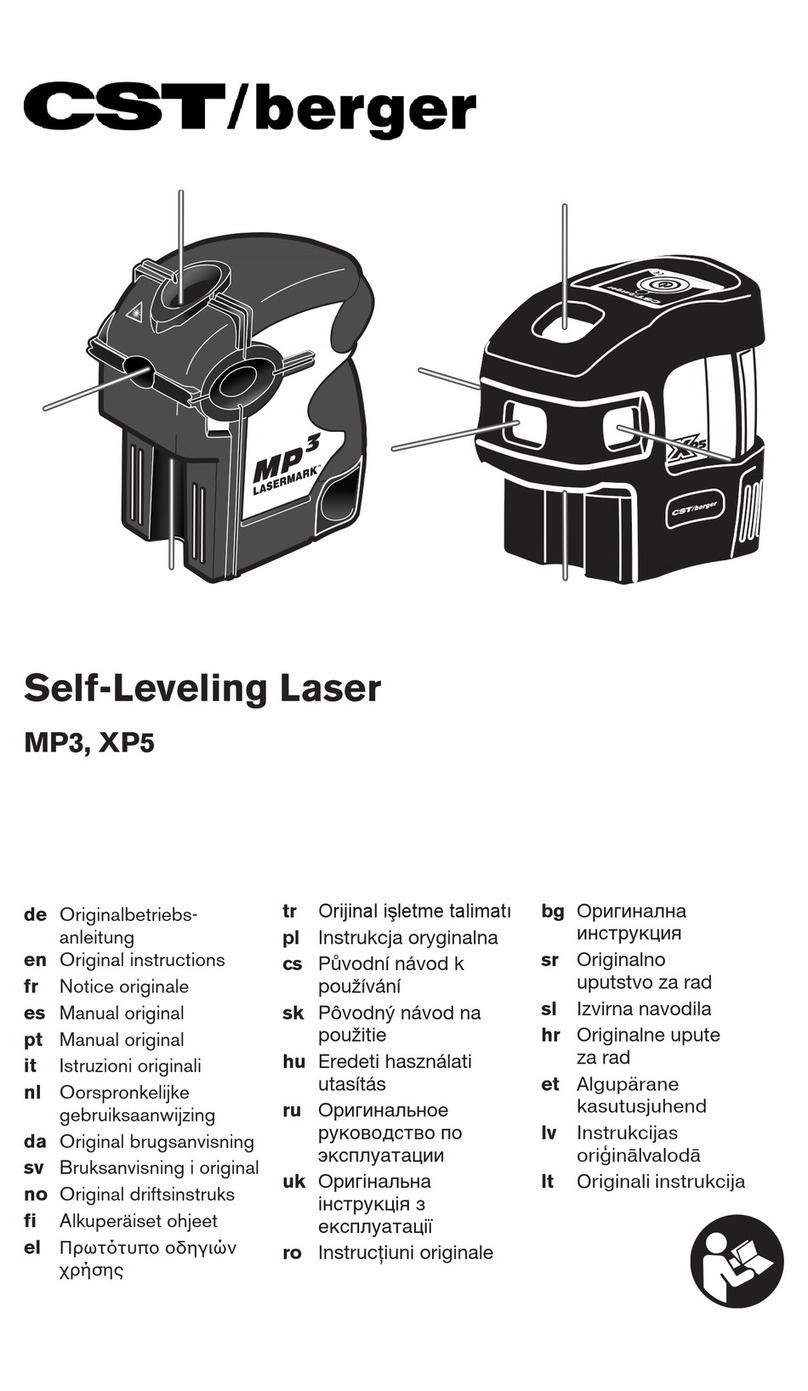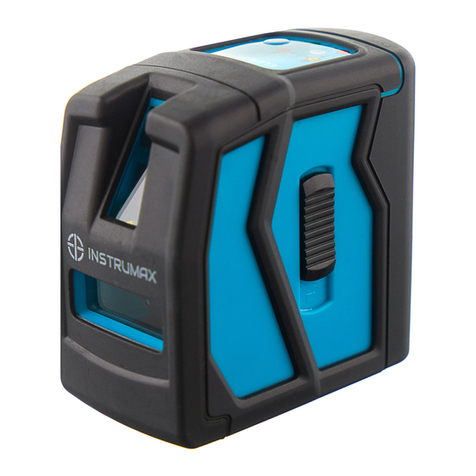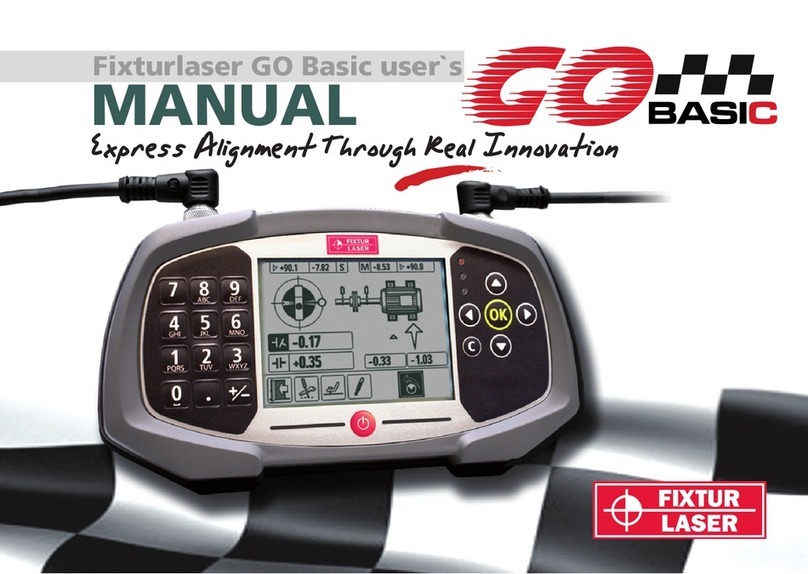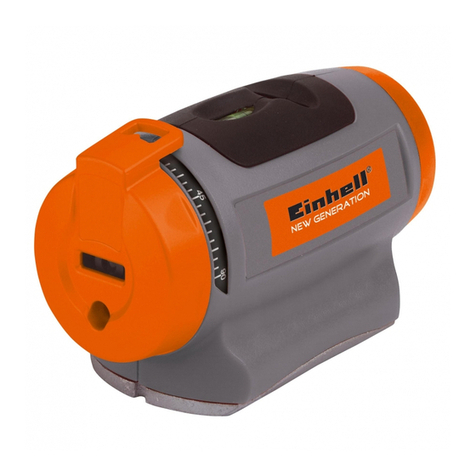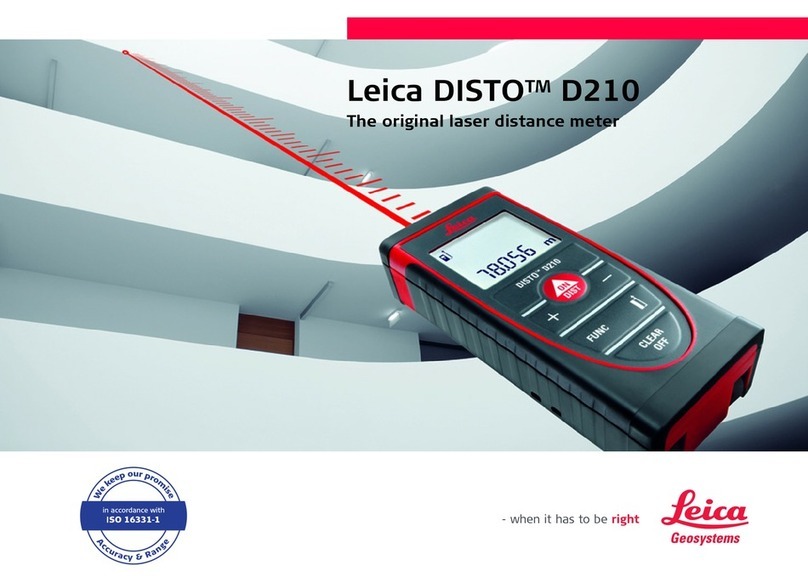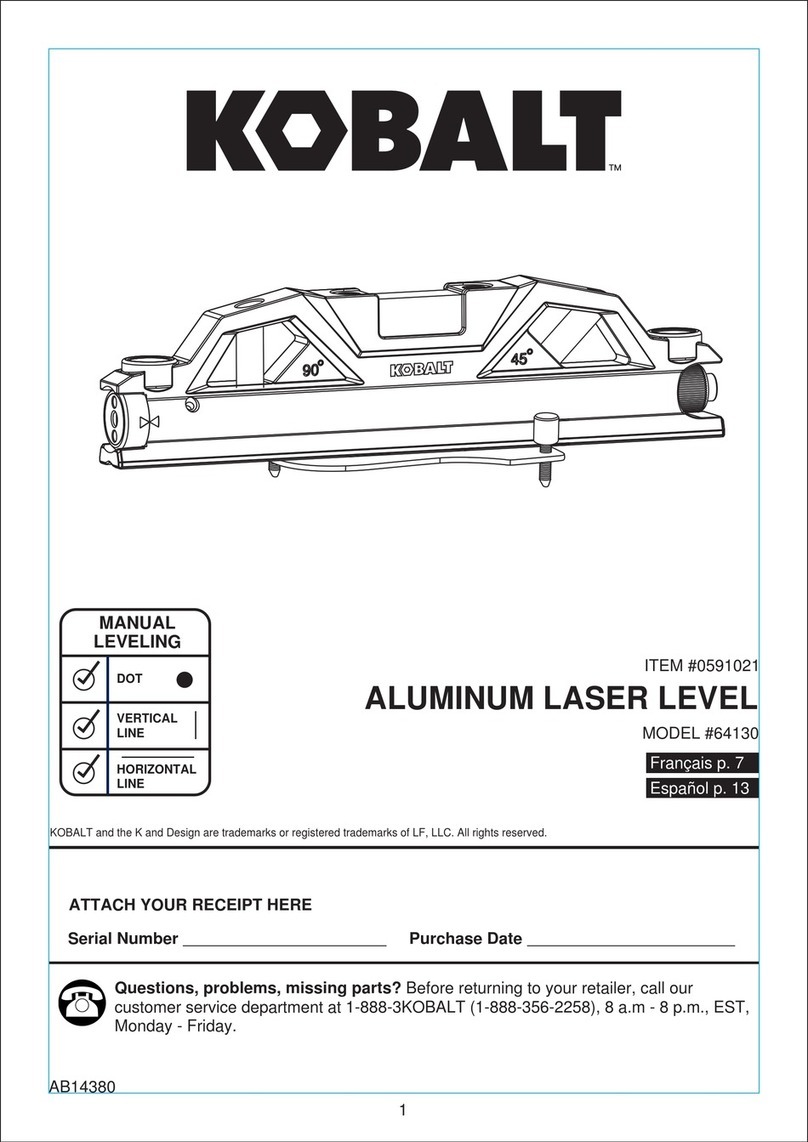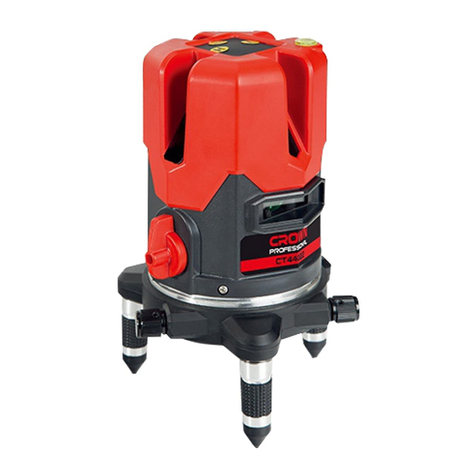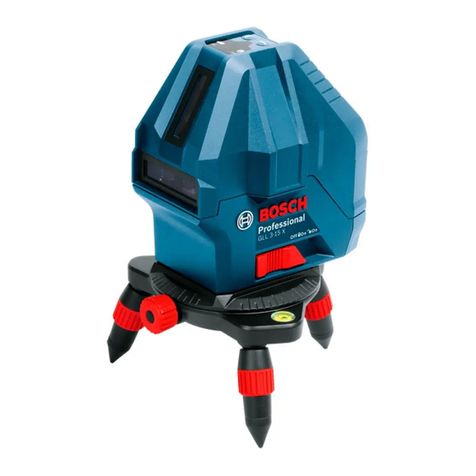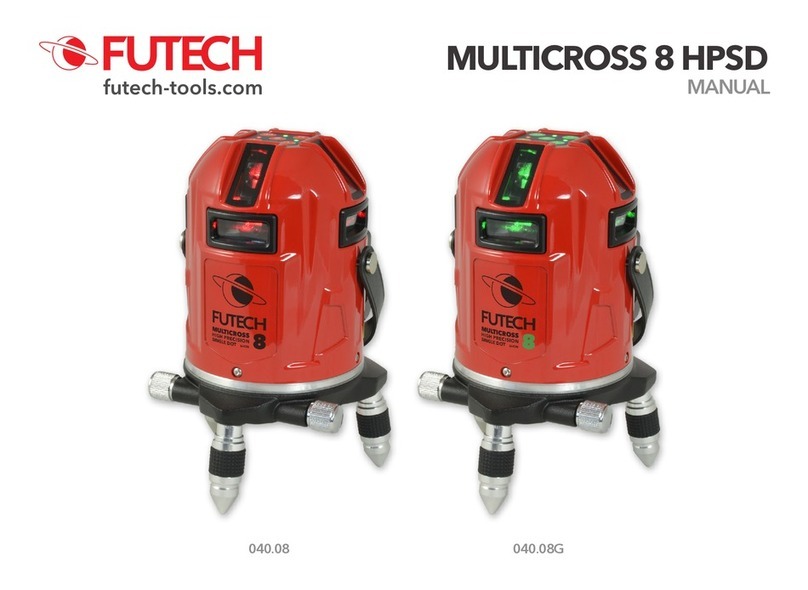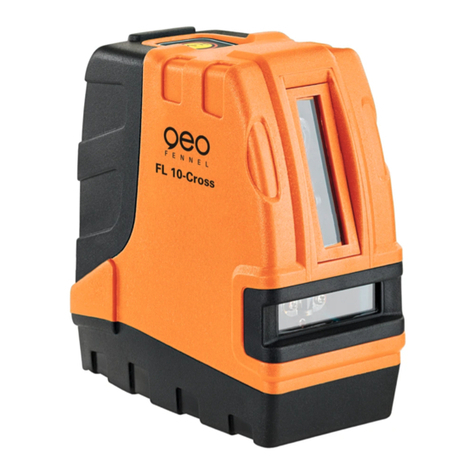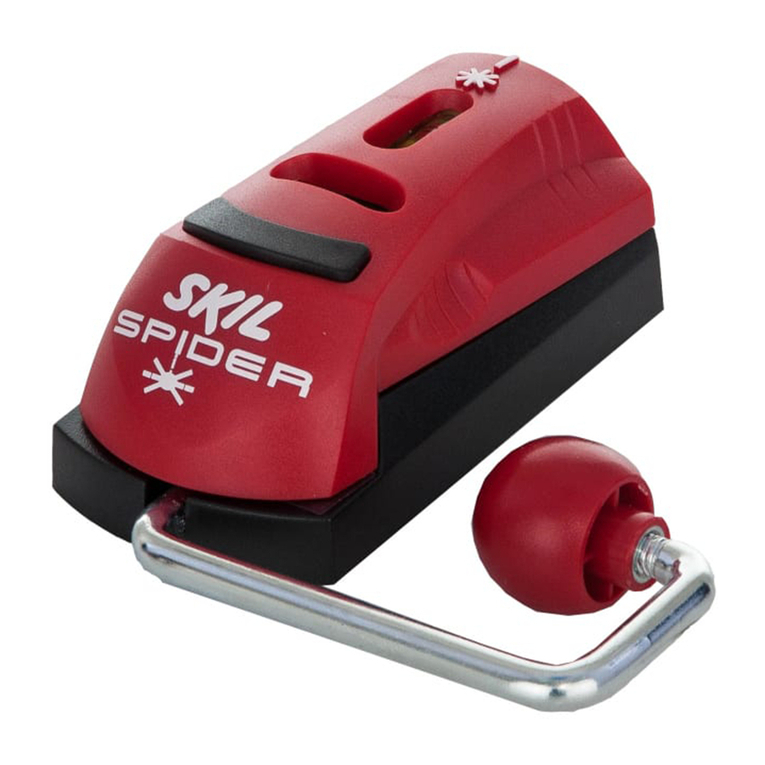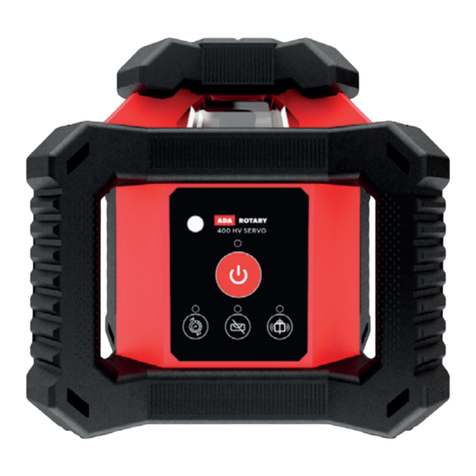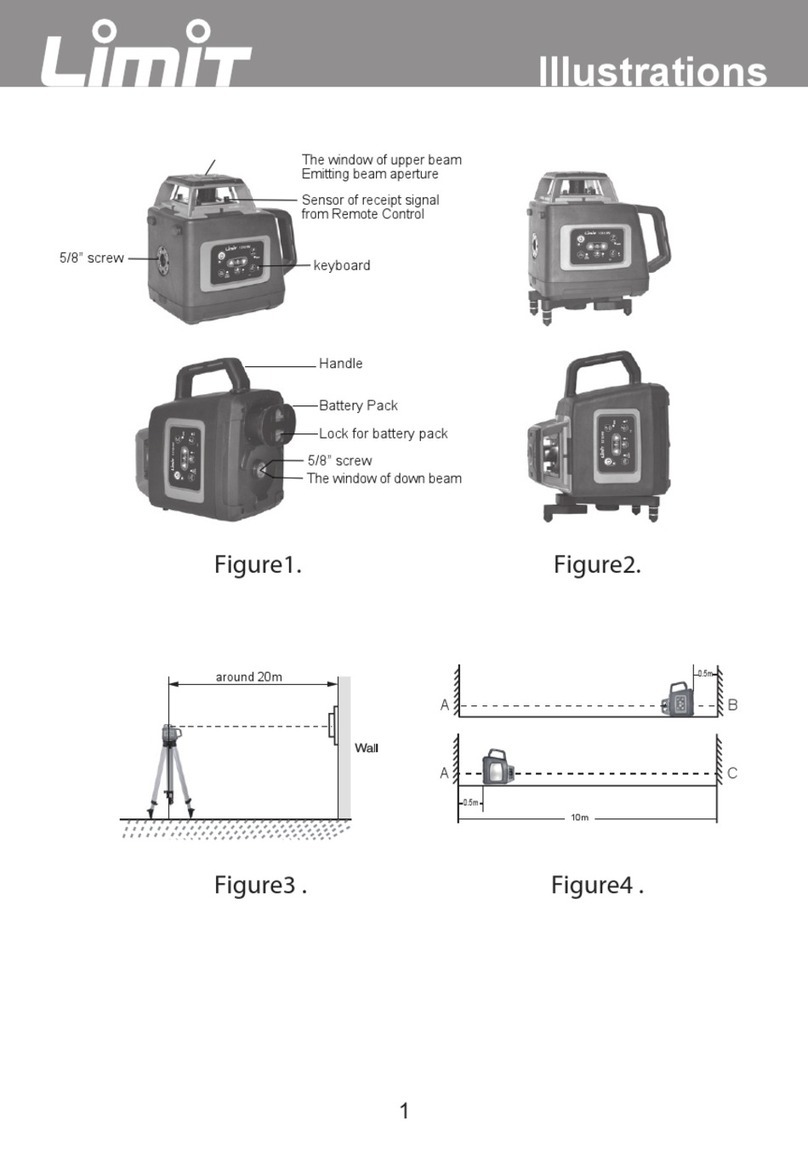CST Berger Lasermark Wizard LM30 User manual

IInnssttrruuccttiioonnMMaannuuaall
MMaannuuaallddeeIInnssttrruucccciioonneess
MMaannuueelldd’’IInnssttrruuccttiioonnss
MMaannuuaalleeddiiIIssttrruuzziioonnii
BBeeddiieennuunnggssaannl
leeiittuunngg
IInnssttrruuççõõeessddeeUUttiilliizzaaççããoo
INSTRUCTION MANUAL

2 • LM30 Rotary Laser
Copyright © 2003-2005 CST/berger. All rights reserved. This document shall not be copied or
otherwise reproduced without CST/berger’s written consent. LaserMark® is a registered trade-
mark of CST/berger.
6
44
7
8
5
10
11
12
13
1
2
3
6
FFiigg..11

LM30 Rotary Laser • 3
2
3
4
1
7
6
5
8
Function Buttons
Clock-wise Head Positioning
Counter-lock-wise Head Positioning
Fast
Rotate
Slow
Rotate
Spot
Mode
Long
Sweep
Short
Sweep
CCW CW
RC 100
12345
Clock-wise Head Positioning
Counter-clock-wise Head Positioning
Fast
Rotate
Slow
Rotate
Spot
Mode
Long
Sweep
Short
Sweep
CCW CW
RC30
12345
Rotary Laser Level
Remote Control
1
23
FFiigg..22
FFiigg..55
FFiigg..33FFiigg..44

Thank you for purchasing the LaserMark® Wizard LM30 Rotary
Laser. Please read this manual thoroughly before operation.
The information contained herein is proprietary information of
CST/berger, and is subject to change without notice.
FEATURES (Fig. 1)
1. Laser Emitting Window (Plumb Beam) 2. Rotary Head
3. “Y” Level Vial 4. “X” Level Vial
5. “Y” Leveling Screw & Plumb Vial Leveling Screw 6. “X” Leveling Screw
7. Plumb Vial 8. Control Button
9. Laser Emitting Window (Level Beam) 10. Trivet
11. Battery Door Screw 12. Battery Door
13. Base with two 5/8” - 11 Mounting Thread
CONTROL BUTTON OPERATION (Fig.2)
1. POWER/CONTROL BUTTON - LEDs indicate operation mode
2. PRESS CONTROL BUTTON ONE TIME to turn unit on; rotation begins in
FAST” Speed (approx. 600 RPM).
3. PRESS TWO TIMES for “SLOW” Speed (approx. 150 RPM).
4. PRESS THREE TIMES to “STOP” rotary head (laser remains lit).
5. Press FOUR TIMES to use Long Sweep
6. Press FIVE TIMES to use Short Sweep
7. Low Battery Indication Light
8. Remote Control Window
PRESS CONTROL BUTTON SIX TIMES to turn unit off (no LED’s remain lit and
the laser is OFF).
4 • LM30 Rotary Laser
EN

LASER SAFETY
The use of controls, adjustments, or the performance of procedures other
than those specified herein may result in hazardous radiation exposure.
Do not stare into the laser beams. Do not disassemble the instrument or
attempt to perform any internal servicing.
Repair and servicing of this laser are to be performed only by CST or author-
ized service centers.
This laser complies with all applicable portions of title 21 of the Code of
Federal Regulations set by: the Dept. of Health, Education, and Welfare; the
Food and Drug Administration; the Center for Devices; and the Bureau of
Radiological Health.
The laser LM30 has also been tested and complies with the CE certification
requirements set forth in the EC regulations 89/336/EEC and EN 61000-6-1
(EN50082-1), EN 61000-6-3 (EN50081-1) and IEC 60-825-1.
OPERATION
Basic Leveling
As with any level referencing instrument, checking calibration before each
use is recommended.
1. Set the instrument on any smooth surface, or mount to a 5⁄8" x 11 tripod
and adjust to desired height.
2. Use the leveling screws and level vials to level the instrument. Each lev-
eling screw controls the vial opposite the screw (the front leveling
screw controls the “Y” axis, and the side leveling screw controls the
“X” axis).
LM30 Rotary Laser • 5

NOTE: The more accurately the vial bubbles are centered, the more accurate
the laser beam will be for referencing level.
3. Turn power on and press the control button once for “FAST” speed
(ideal for use outdoors with a laser detector), or twice for “SLOW”
speed (ideal for indoor use). You have created a highly visible, level ref-
erence line (Fig. 3).
Plumbing
1. On a flat surface, place the instrument on its back using the built-in triv-
et (control button facing upward).
2. Level the instrument by viewing the plumb vial and turning the front lev-
eling screw until the plumb vial bubble is centered (Fig. 4).
3. Turn power on and press the control button until you reach your desired
speed. You have created a highly visible, plumb reference line!
Stopping the Rotary Head
It is possible to stop rotation of the head in order to manually direct the laser
dot towards a target, much like a straight-line laser.
1. Turn the unit on by pressing the control button.
2. Press two more times until the “STOP” LED is lit. The rotary head will
stop turning.
3. Align the laser beam to your target by turning the rotary head manually.
Sweep Modes (Point & Shoot Scanning)
The LM30’s Sweep Modes create an easily visible laser “chalk line” that you
can direct by manually turning the rotary head.
This is especially useful on job sites where you must contain the laser’s loca-
tion to avoid interference with other laser users or laser detectors on site.
Also, this feature is very useful for extending the range of the visible beam.
You may use this feature in either a level or plumb position.
6 • LM30 Rotary Laser

1. Turn the unit on by pressing the control button.
2. Press three more times until the “LONG SWEEP” LED is lit. The rotary
ad will quickly scan back and forth to create a laser “chalk line”.
3. To direct the sweep toward your target, grab the rotary head to stop its
movement, and wait for rotation pressure to relax (normally within a
few seconds).
Rotate head to your desired position and release.
4. Length of the chalk line will vary depending on the distance of the
Wizard from your working surface; the angle of the long sweep is
approximately 45°. To create a shorter, faster sweep, press the control
button once more (”SHORT SWEEP“ LED will light); the angle of the
short sweep is approximately 22°.
Note: The Sweep Function of this unit is intended for indoor use only. Use of
the LM30 in direct sunlight may result in erratic operation of the Sweep
Function.
Use of the LM30 in direct sunlight will not affect any other functions
Remote Control RC30 - (Fig. 5)
Note: Remote control is included with LM30 Interier packages.
The remote controls Fast Rotation Speed, Slow Rotation Speed, Spot Mode,
Long Sweep, Short Sweep, and can be used up to a maximum of 100 feet (30
m) away from the unit. The user must face the control panel for proper oper-
ation of the remote. Requires 2 AA Alkaline batteries.
1. Operates same as the single button on unit
2. Rotate laser beacon counter-clock-wise when in sweep or spot mode
3. Rotate laser head clock-wise when in sweep or spot mode
LM30 Rotary Laser • 7

APPLICATIONS (Fig.6)
Installing drop ceiling and grid and tiles. Use with Wall/Ceiling Mount
INDOOR LEVELING/PLUMBING: Window Frames, Cabinets & Shelves, Doors
& Windows, Erecting Walls & Partitions, Aligning 90° Joints & Edges, Floors,
Tile Work.
OUTDOOR LEVELING/PLUMBING: Porches & Decks, Fencing, Flagpoles,
Batterboards, Landscaping.
POWER
NiCad or Nimh rechargeable batteries do NOT work well in a Laser Level as
their operating voltage is too low. We recommend that only alkaline batteries
be used in your Laser Level. Plain carbon batteries can leak either fluid or
corrosive gas, both of which can damage the Laser Level.
It should be noted that the electronic switch in the Laser. Your LaserMark®
Wizard will provide approximately 60 hours of intermittent use.
The “Low Battery” LED will light when the batteries’ voltage falls below an
optimal level.Also, if your Wizard fails to emit laser beams, but still has func-
tioning LEDs and rotation, your batteries may be low; try replacing the batter-
ies before contacting a service center.
Replacement batteries must be all new batteries; alkalines provide the best
performance.
Replace the batteries as follows:
1. Remove the battery cover by turning the battery cover screw counter-
clockwise.
2. Remove the old batteries and replace with four new “C” cell batteries
as illustrated (Fig. 7), and replace the battery cover.
NOTE: Do not mix old and new batteries. Replace all batteries at the same
time with new batteries. Remove batteries before storage of the instrument
.
8 • LM30 Rotary Laser

CALIBRATION
All Laser Levels are calibrated during assembly and Q.A., howeverLaserLevel
owners should always check the calibration of the unit before use as the
settings may have changed with time or during transportation. It is also wise
to recheck the calibration of the Laser Level at regular intervals and also
prior to any critical measurements being performed. A 0.059"(1.5mm) Allen
key will be required to adjust the screws on the two leveling vials, and a
5/64” (2mm) one to adjust the LD vial.
Checking Horizontal Rotation Error
1. Mount and level the LaserMark® Wizard on a tripod and place approxi-
mately 50 feet (15m) away from a wall. Face the front (control button) to
the wall (Fig.8).
2. Turn power on and place the unit in “STOP” mode.
3. Manually rotate the laser beam onto the wall and mark as point A.
4. Loosen the Wizard from the tripod and rotate the instrument 180° so
that the back (battery side) now faces the wall.
Secure and re-level the instrument.
5. Again rotate the laser beam onto the wall and mark its position as point
B. No adjustment is necessary if the vertical difference between points
A and B is 1⁄8 inch (3mm) or less. Otherwise, adjust as follows.
Correcting Horizontal Rotation Error
1. Adjust the “Y” leveling screw until the laser beam rests midway
between A and B (Fig. 8). This will cause the “Y” vial bubble to shift
from center. Clockwise rotation will raise the beam; counterclockwise
rotation will lower the beam.
2. Center the “Y” vial bubble by adjusting the vial leveling screws with a
1.5mm hex key.
3. Recheck the accuracy of horizontal rotation by repeating steps 1-5 in
LM30 Rotary Laser • 9

section”Checking Horizontal Rotation Error”. Readjust as
necessary.Repeat the above checking and adjusting procedures using
the left and right sides of instrument, adjusting the “X” leveling screw
and “X” vial as necessary.
Checking Vertical Rotation Error
1. Set the instrument on its trivet (control button upward) on a floor
approximately 100 feet (30m) from the base of a wall. The right side of
the instrument should face the wall. Level the unit by adjusting the “Y”
leveling screw.
2. Turn power on and place the unit in “STOP” mode.
3. Mark a control point “A” on the wall (Fig. 9). Turn the rotary head manu-
ally until the laser beam hits point A on the wall.
4. Turn the rotary head to move the laser beam 30 feet (9m) upward on the
wall and mark this as point B.
5. Turn the instrument 180° and align the beam to point A, re-leveling if
necessary (Fig. 10).
6. Turn the rotary head to move the laser beam to the same height as point
B, and mark as point C.
No adjustment is necessary if the difference between points B and C is 1⁄8
inch (3mm) or less. Otherwise, adjust as follows.
Correcting Vertical Rotation Error
1. Adjust the “Y” leveling screw until the laser beam rests midway
between points B and C. This will cause the plumb vial bubble to shift
from center.
2. Center the plumb vial bubble by adjusting the vial leveling screws with a
5/64”(2mm) hex key.
3. Recheck the accuracy of vertical rotation by repeating steps 1-6 in sec-
tion”Checking Vertical Rotation Error”. Readjust as necessary.
10 • LM30 Rotary Laser

SETTING UP
Correct set-up of any manual Laser Level is critical to the operation of the
Level. These Laser Levels do not adjust themselves automatically. The accu-
racy of the job depends entirely upon how well the unit has been set-up. An
error of only 0.02" (0.5mm) at the top of the tripod becomes an error of 4" at
65 feet (100 mm at 20 meters). In order to achieve the accuracy required
some special precautions should be observed.
1. The head of the Laser Level is fitted with two engineering grade spirit lev-
eling vials which are extremely accurate and very sensitive. When the Level
is being set-up the bubbles move quite slowly and may even stick inside the
vial. This is called stiction. The solution is to lightly tap the non-rotating part
of the Level with the tip of a finger until the bubble ceases to move.
2. When attaching the Laser Level to the tripod, the instrument fastening
screw should not be over-tightened. If the screw is tightened excessively
then the trivet base will become distorted and over a period of time the plas-
tic material of the trivet will relax, particularly if the day is hot, causing the
setting of the Level to change. In extreme cases it is possible to pull the cen-
tre insert out of the trivet.
MAINTENANCE
Always clean the instrument after use. Use a soft, dry cloth to remove any
dirt or moisture from the instrument. Store the unit in its case when not in
use. Batteries should be removed before long-term storage.Do not use ben-
zene, paint thinner, or other solvents to clean the instrument.
ENVIRONMENT PROTECTION
Recycle raw materials instead of disposing as waste.The machine, acces-
sories and packaging should be sorted for environmentalfriendlyrecycling.
Do not throw used batteries into house waste, fire or water but
dispose of in an environmentally friendly manner according to the
applicable legal regulations.
LM30 Rotary Laser • 11

12 • LM30 Rotary Laser
SPECIFICATIONS
AApppprrooxxiimmaatteeRRoottaattiioonnSSppeeeedd::600 RPM–OUTDOOR; 150 RPM–INDOOR.
When using optional detector, highest
RPM mode is recommended.
HHoorriizzoonnttaallAAccccuurraaccyy::1⁄4" at 100 feet (6mm at 30m)
VVeerrttiiccaallAAccccuurraaccyy::15/32” at 100 feet (12 mm at 30 m)
RRaannggee::Up to 200 feet (60m) diameter interior,
up to 800 feet (240m) diameter exterior
with optional laser detector
LLaasseerrDDiiooddee::635nm
LLaasseer
rCCllaassss::3R
LLeevveell&&PPlluummbbVViiaallSSeennssiittiivviittyy::Level, 5-8 minutes; plumb, 15 minutes
MMoouunnttiinnggSSccrreeww::5⁄8" x 11 for standard tripods
WWeeiigghhtt::3.6 lbs. (1.6kg) with batteries
PPoowweerr::Four “C” cell batteries provide approxi-
mately 60 hours of intermittent use
Specifications subject to change without notice.

LM30 Rotary Laser • 13
UNIVERSAL LASER DETECTOR
Introduction
The Universal Laser Detector aids in locating and targeting a visible or invisi-
ble beam emitted by a rotary laser; perfect for use in outdoor conditions,
where sunlight and distance may make locating the beam more difficult.
Features (Fig. A)
1. LCD readout window 2. Speaker
3. Beam capture window 4. Power ON/OFF
5. Beam resolution 6. Volume ON/OFF
7. LCD readout window (LD-400 and LD-120 only) 8. Battery door
Operation
1. Turn on the unit by pressing the ON/OFF pad. The LCD symbols will
momentarily flash (Fig. B).
2. Expose the beam capture window of the laser detector towards the
direction of the rotating laser.
3. Slowly move the laser detector in an upward and downward direction
until the LCD beam indicator arrows appear and/or a pulsing audio sig-
nal is heard. Select the desired Beam Resolution, according to the job
conditions and the precision required (to see the available Resolutions,
please refer to the Specs Table).
4. Move the detector upward when the low beam indicator light is lit (with
volume on, a short pulsing audio tone is heard). Move the detector
downward when the high beam indicator arrow is lit (with volume on, a
long pulsing audio tone is heard). When the beam is level, the level
beam indicator line will be lit and a solid audio tone will be heard.
If the detector is not struck by a laser beam after 5-8 minutes, the detector
will automatically shut itself off to preserve battery life.
Turn the unit back on using the power button.

14 • LM30 Rotary Laser
Special features
The laser detector includes a rod clamp which allows to mount the detector
onto square, round or oval sighting rods.
The detectors are gasket sealed for water and dust protection. Remove any
moisture or dirt with a soft, dry cloth.
Do not use aggressive cleaning agents or solvents. Remove batteries before
storage of the instrument.
The LCD display of the detector LD-400 has seven distinct channels of infor-
mation, indicating the position of the detector in the plane of laser light, as
indicated in Fig. C (the detectors LD-120 and LD-100N have three).
As you move the detector closer to the center, the arrows fill in to indicate
the laser position.
The detector has a unique memory feature, which preserves the last position
of the laser beam if the detector is moved out of the plane of laser light, as
well as built in electronic filtering for bright sunlight and electromagnetic
interference.
The detector LD-400 has three speaker selections (Off, Loud (105dBA) and
Louder (125+ dBA)), whereas the models LD-120 and LD-100N have only two
(Off and On).
Power
A 9-volt battery will provide up to 3 months of typical usage. When the unit is
turned on and the low battery symbol remains lit, the battery should be
replaced.

Specifications
Note: Sensitivity values based on standard conditions with most lasers; may
vary slightly due to make, manufacturer, beam size, or working conditions.
LM30 Rotary Laser • 15
DDeessccrriippttiioonnLLDD--440000LLDD--112200LLDD--110000NN
Dimensions 6.6” H x “ W x 1” D (169mm x 76mm x 25mm)
Weight 10 oz. (275g)
Range Up to 800-ft (305m) Radius with LM30
Beam Resolution *
Fine ±0.75mm
Medium ±1.5mm
Wide ±3mm
Medium ±1.5 mm
Wide ±3 mm
Medium ±1.5mm
Wide ±3mm
Readout LCD, 2 windows LCD, 2 windows LCD, 1 window
Power One 9-volt battery provides 3 months of typical usage

16 • LM30 Rotary Laser
Warranty
One Year Warranty. CST/berger,
a division of Stanley Works
, warrants this
electronic measuring tool against deficiencies in material and workmanship
for a period of one year from the date of purchase. Deficient products will
be repaired or replaced at CST/berger's option. Proof of purchase is
required.
For warranty and repair information, contact:
YYoouurrLLooccaallDDiissttrriibbuuttoorr,,oorrCCSSTT//bbeerrggeerr..
This Warranty does not cover deficiencies caused by accidental damage,
wear and tear, use other than in accordance with the manufacturer's
instructions or repair or alteration of this product not authorized by
CST/berger.
Repair or replacement under this Warranty does not affect the expiry date of
the Warranty. To the extent permitted by law, CST/berger shall not be liable
under this Warranty for indirect or consequential loss resulting from defi-
ciencies in this product.
Agents of CST/berger cannot change this warranty. This Warranty may not
be varied without the authorization of CST/berger.
This warranty may provide you with additional rights that vary by state,
province or nation.
IIMMPPOORRTTAANNTTNNOOTTEE: The customer is responsible for the correct use and
care of the instrument. Moreover he is completely responsible for checking
the job along its prosecution, and therefore for the calibration of the instru-
ment. Calibration and care are not covered by warranty.
Subject to change without notice

Gracias por haber escogido nuestro Laser LM30.
CARACTERISTICAS (Fig. 1)
1 Rayo laser vertical (plomada) 2 Cabeza rotatoria
3. Burbuja horizontal eje “Y” 4 Burbuja horizontal eje “X”
5 Tornillo nivelación eje “Y” y plomada (vertical) 6 Tornillo nivelación eje “X”
7 Burbuja vertical 8 Botón de control
9 Rayo laser horizontal (nivelación) 10 Soporte
11 Tornillo de la tapa 12 Tapa de las pilas
13 Soporte base con dos roscas 5/8” - 11
FUNCIONAMIENTO DEL BOTÓN DE CONTROL (Fig. 2)
1. BOTÓN DE CONTROL – los LEDs indican la función seleccionada2.
Presionar UNA VEZ para encender la unidad; la rotación comienza en
velocidad de “EXTERIOR” (aprox. 600 RPM)
3. Presionar DOS VECES para seleccionar la velocidad de “INTERIOR”
(aprox. 150 RPM)
4. Presionar TRES VECES para parar la cabeza rotatoria (el láser per-
manece encendido)
5. Presionar CUATRO VECES para seleccionar el “barrido largo”
6. Presionar CINCO VECES para seleccionar el “barrido corto”
7. Indicación de carga de las pilas
8. Ventana de recepción del mando a distancia
Presionar SEIS VECES para apagar la unidad (ningún LED permanece encen-
dido)
LM30 Rotary Laser • 17
E

SEGURIDAD Y ESPECIFICACIONES
Es posible trabajar con el aparato sin peligro, sólo después de haber leído
atentamente las instrucciones para el uso y las advertencias de seguridad, y
siguiendo estrictamente las instrucciones.
El uso de instrumentos opticos, controles, ajustes o procedimientos de fun-
cionamiento distintos a los especificados en el presente manual pueden
provocar una exposicion a radiación peligrosa
No mirar hacia el rayo. No apuntar el rayo láser hacia otras personas. No
desmontar el instrumento, ni intentar hacer ningúna reparación. La
reparación y el mantenimiento de este láser deben ser realizados solamente
por CST o centros de servicio autorizados.
El equipo cumple con todas las especificaciones del artículo 21 del Código
de Regulación Federal (U.S.A.) el Departamento de Sanidad, Educación,
Alimentación y del Centro para la Salud Radiológica.
El láser LM30 también cumple con las especificaciones CE según las normas
89/336/EEC,EN 61000-6-1 (EN50082-1),EN 61000-6-3 (EN50081-1) y IEC 60-825-1
Copyright© 2003-2005 CST/berger. Derechos reservados.
Toda esta información es propiedad de CST/berger .
Este documento no debe ser copiado o reproducido sin el consentimiento
escrito de CST/berger. LaserMark® es una marca registrada de CST/Berger.
18 • LM30 Rotary Laser

FUNCIONAMIENTO
Nivelación
Como para cualquier instrumento de nivelación, se aconseja controlar la cal-
ibración del instrumento antes del trabajo (ver capítulo “CALIBRACIÓN”).
1. Colocar el LM30 sobre cualquier superficie lisa o montarlo en un
trípode estándar con rosca de 5/8” - 11.
2. Utilizar los tornillos de ajuste y las burbujas de nivelación para nivelar
el instrumento. Cada tornillo de nivelación controla la burbuja opuesta
al tornillo (el tornillo nivelador frontal controla el eje “Y”, y el tornillo
nivelador lateral controla el eje “X”).
Nota: Cuanto más exactamente centradas estén las burbujas, más precisa
será la señal del láser para el nivel de referencia. Asegurar que las burbujas
están estables.
3. Encender el láser y presionar una vez el botón de control para con-
seguir la velocidad “alta” (ideal para trabajar en el exterior con un
receptor láser), o dos veces para conseguir la velocidad “baja” (ideal
para trabajar en el interior). De esta forma se ha obtenido una línea de
referencia a nivel muy visible (Fig. 3).
Plomada
1. Sobre una superficie plana, colocar el láser sobre la parte posterior uti-
lizando el soporte (botón de control hacia arriba).
2. Nivelar el instrumento controlando la burbuja de la cara superior medi-
ante el tornillo nivelador “Y” (superior) hasta que la burbuja esté cen-
trada (Fig. 4).
3. Encender la unidad y presionar el butón de control hasta que se
alcance la velocidad deseada. De esta forma se ha obtenido una línea
de referencia vertical a nivel muy visible.
LM30 Rotary Laser • 19

Parada de la cabeza rotatoria
Es possible interrumpir la rotación de la cabeza para dirigir manualmente la
señal del láser hacia el objetivo deseado, como en un nivel láser de línea.
1. Encender el láser presionando el botón de control.
2. Presionar dos veces más hasta que la señal “STOP” esté encendida. La
cabeza rotatoria dejará de girar.
3. Alinear la señal de láser hacia su objetivo girando la cabeza manual-
mente.
Funcionamiento del modo “barrido”
El modo “barrido” del láser LM30 crea una línea láser muy visible, que puede
ser dirigida girando manualmente la cabeza rotatoria. Esto es particular-
mente útil cuando hay que delimitar el área del rayo láser para evitar inter-
ferencias con otros láser o receptores en la obra. Además con esta función
se aumenta de una manera considerable la visibilidad del rayo láser. Se
puede utilizar esta función en horizontal y en vertical.
1. Encender el láser presionando el botón de control.
2. Presionar tres veces más hasta que la señal “barrido largo” esté
encendida. La cabeza rotatoria empezará a girar hacia un lado y hacia
el otro para crear una línea de “barrido”.
3. Para dirigir el barrido hacia su objetivo, coger la cabeza rotatoria con
suavidad para parar la rotación y esperar que el motor baje su fuerza
(normalmente unos segundos). Girar la cabeza hacia el objetivo desea-
do y soltarla. Esta operación debe hacerse con mucha suavidad para
no dañar la cabeza giratoria.
4. La longitud del barrido varia según la distancia entre el láser y su obje-
tivo; el ángulo del barrido largo es de aprox. 45°. Para crear un barrido
más corto y más veloz, presionar otra vez el botón de control (la señal
de “barrido corto” está encendida); el ángulo del barrido corto es de
aprox. 22°.
20 • LM30 Rotary Laser
Other manuals for Berger Lasermark Wizard LM30
1
Table of contents
Languages:
Other CST Laser Level manuals
